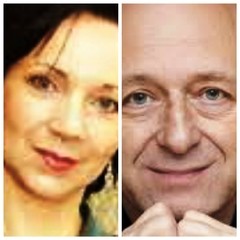|
Back
Ancient Songs and Dances New York
Isaac Stern Auditorium, Carnegie Hall
04/06/2019 - January 26, 2019*
Traditional: Romanian Folk Dances – Hungarian Peasant Songs
Béla Bartók: Romanian Folk Dances, BB 76 – Hungarian Peasant Songs, BB 107 – A kékszakkallú Herceg Vára, BB 62, Opus 11
Márta Sebestyén (Vocalist), Ildikó Komlósi (Judith), Krisztián Cser (Bluebeard), István Kádár (Violin), András Szabó (Viola), Zsolt Fejérvári (Bass)
Budapest Festival Orchestra, Iván Fischer (Founder, Conductor)

B. Bartók (fourth from left) recording folk music
“A genuine peasant melody of our land is a musical example of perfected art. A masterpiece in miniature as a Bach fugue or Mozart sonata is a masterpiece in the large forms.”
Béla Bartók (1881-1945)
“I guess all songs is folk songs. I never heard no horse sing ’em.”
Big Bill Broonzy (1893-1958)
One day, the real story about the Iván Fischer’s formation of the Budapest Festival Orchestra will be told. I followed it while editing a magazine in Budapest, but in the meantime, this most imaginative, accomplished and deft conductor has gone from triumph to triumph. Each victory totally unexpected.
As the world’s leading conductor of Béla Bartók, his first concert, as reviewed by ConcertoNet’s Fred Kirshnit and others in Carnegie Hall was shatteringly good. Last night, he gave us a grand surprise. Not only Romanian and Hungarian songs orchestrated and altered by Bartók, but the original music from which the familiar pieces were generated.
Were these English folk songs, it would be worth a yawn of two. But the music of Hungary has a language and culture and music which is absolutely unique. In the archive picture above, we see Bartók, having spent days through the mud and mountains of his native Hungary, recording perhaps the last Transylvanian singers and instrumentalists. Back in Budapest, he first set these songs–as well as peripatetic studies in Romania, Bulgaria and Turkey–to a kind of Western notation. (Though obviously the sounds needed original diacritical notes.) He then re-set the original melodies for piano and/or singer, and later perhaps for orchestra.
Such was the verisimilitude of Bartók, that he never “gentrified” this music. At the same time, he knew that the music could be changed, made brighter, and become part of his own personal canon, by radiant orchestration, changes of tempo and mode.
These are the songs which concert halls know today. Mr. Fischer presented, though, with great joy, the musicological singularity of the original songs. Three of the Budapest Festival Orchestra ensemble presented the Romanian dances first. Fiddler István Kádár with violist and bassist András Szabó and Zsolt Fejérvári gave new sounds to their instruments. Sometimes harsh, more frequently with quarter-tones, always intense, to the music which Bartók (and his colleague in 1904 Zoltán Kodály) heard.
After that, Mr. Fischer led the Budapest Festival Orchestra in the popular dances we know so well.

M. Sebestyén/I. Fischer
If that was a discovery, the following Hungarian songs and dances were a revelation. I had heard Márta Sebestyén several times when living in Budapest. Last night, this great–okay, this mighty–artist, with the same trio behind her, sung, uttered, crooned and came near dancing the original Transylvanian music. One wanted to say she was a combination of Joan Baez (the first song so lyrically offered) and Pete Seeger. But Ms. Sebestyén was more than that. And for some, it showed a very different side of Hungarian music.
Liszt and Brahms had transcribed so-called Hungarian music, but their tunes came from the Gypsies (the Roma people, so detested in Central Europe today). In New York, the equivalent of alleged Hungarian music is the klezmer. And while the Budapest Festival Orchestra clarinets had klezmer accents, music sung here had strange modalities, offbeat rhythms, sometimes wild melismas, with voices at times added by Mr. Fischer and some in the band.
It was a joyous performance, a rare performance, an ecstatic performance. And her long encore could have gone on forever, before Mr. Fischer led the Budapest Festival Orchestra in the wondrous Bartók orchestration. When Mr. Fischer retards a dance or changes tempos in the middle, one knows that it is right.

K. Cser/I. Komlósi
The second half showed another face of Béla Bartók. Duke Bluebeard’s Castle, written in 1911, had its folk element in the surrealist, desolate, highly pictorial story. Bartók, though, never used anything approaching a folk song. It was his own passion and his super-romantic–tendencies which make this opera one of the four greatest of the 20th Century.
Should it have been staged here? I’ve seen two stage performances. One by a Canadian opera company whose holograms, whose lighting, whose special effects almost dwarfed the greatness of the music. Another was in Budapest, probably close to the original performance, with curtain as doors, with no special effects, and where one listened so closely to the music.
Here we started with the rare prologue, spoken in Magyar by Mr. Fisher like a poetic Bard. The two soloists here were more than competent, especially Krisztián Cser as Bluebeard. What a rich great bass voice he has! The depth and the volume where one would love to see him as Boris Godunov.
Mr. Fischer has made a recording of the opera with last night’s mezzo, Ildikó Komlósi, yet her voice seemed rather weak. Yes, Bluebeard must lead her on, but Ms. Komlósi lacked the desperation, the emotional puzzles of the original opera.
And true, in the great Christa Ludwig-Walter Berry recording, the calls, the pleadings with Judith were incredibly emotional. Here it was Mr. Cser exhibiting a wonderful voice at a single pitch. (Also, what a joy to hear the pangs, the anxious sound of Magyar, not the German of Ludwig/Berry.)
As for the Budapest Festival Orchestra…if you weren’t there, don’t ask! Iván Fischer gave a picture of haunted strings, of ghostly clarinet playing, of brasses and horns of stunning sounds in their long sustained passages.
As for the orchestra’s climax with the Fifth Door–the Kingdom–this is a climax, a chorale, a massive major-key summation which can shatter any concert hall. In fact, this whole evening was one of astonishment and revelations. Please, Mr. Fischer, you will always have a home in New York. Come back as soon as you possibly can.
CODA: Alas, part of Bluebeard’s Castle was destroyed for me, since I was visualizing the story, the emotions and the desolation as a mirror image of President Trump showing Mar-A-Lago to his new third bride, Melania. She is now entombed in her own unending night, amidst our metaphorical murder and blood. Perhaps some day the sun will shine in, though never so gloriously as Mr. Fischer’s radiance.
Harry Rolnick
|